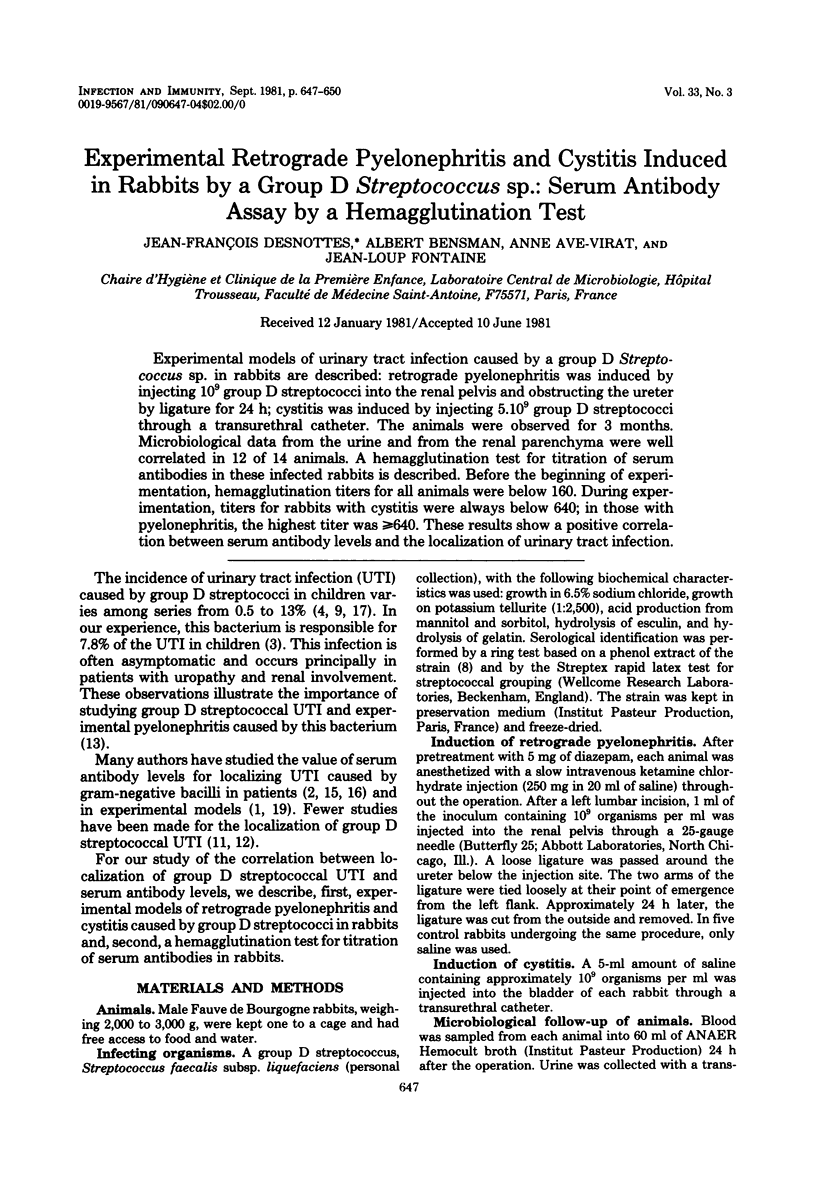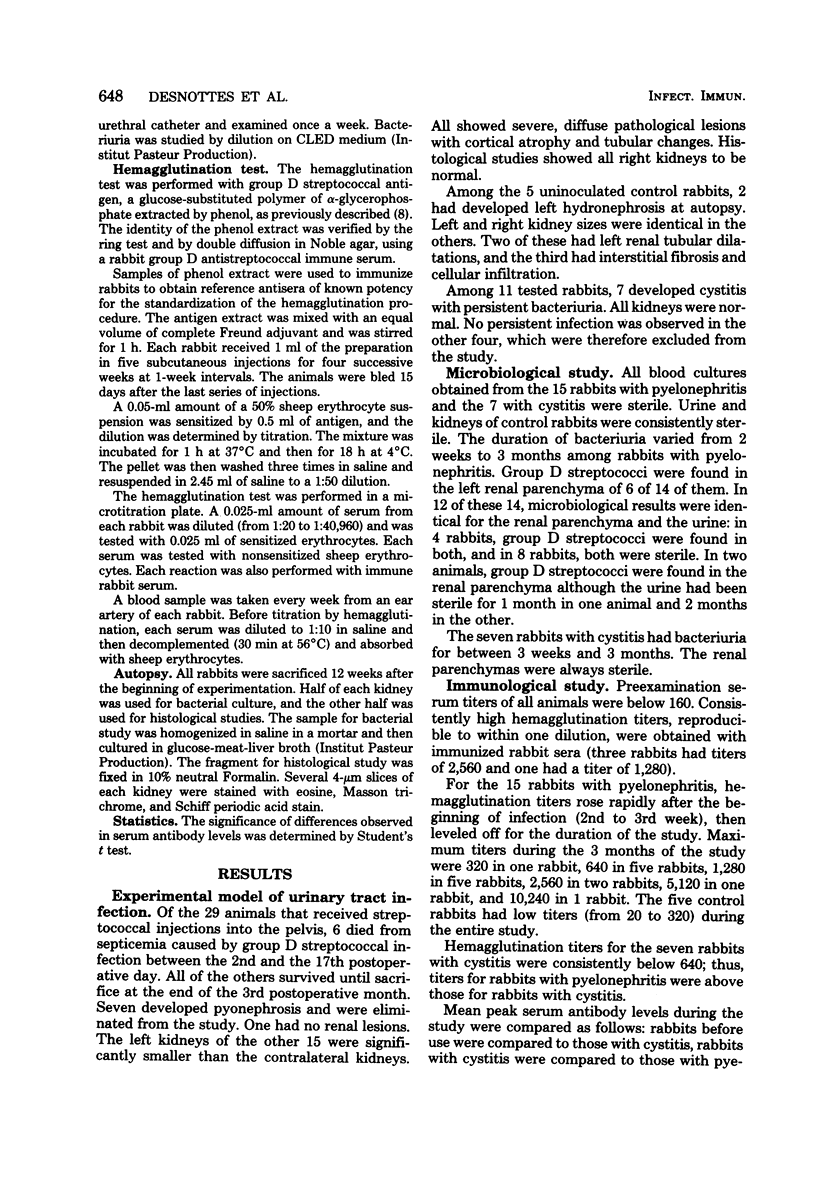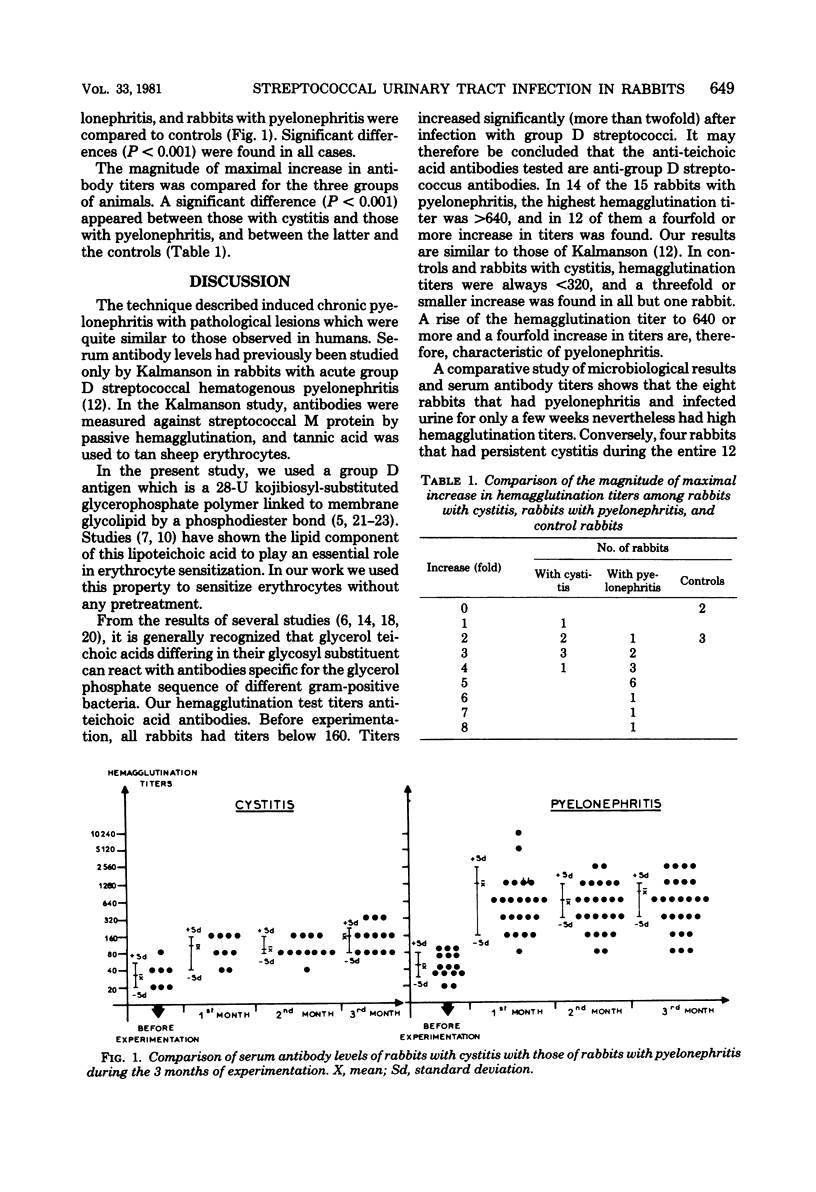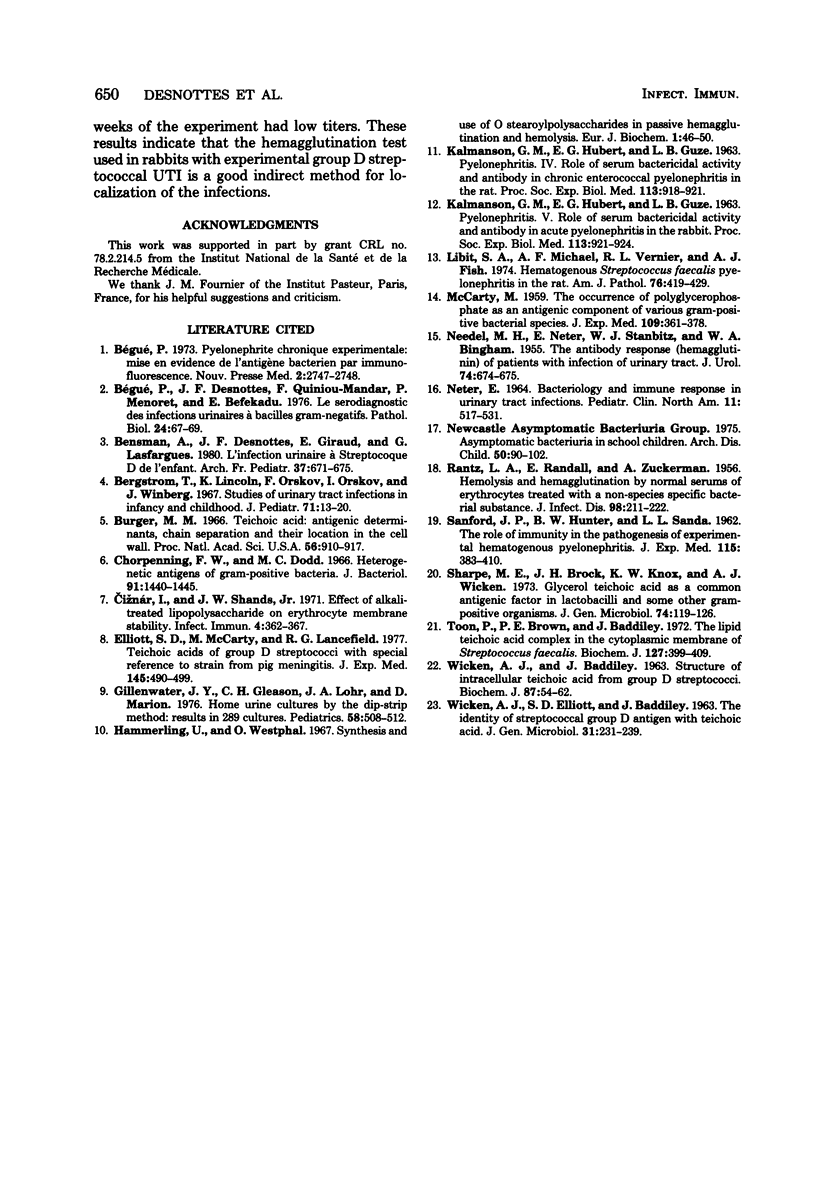Abstract
Experimental models of urinary tract infection caused by a group D Streptococcus sp. in rabbits are described: retrograde pyelonephritis was induced by injecting 10(9) group D streptococci into the renal pelvis and obstructing the ureter by ligature for 24 h; cystitis was induced by injecting 5.10(9) group D streptococci through a transurethral catheter. The animals were observed for 3 months. Microbiological data from the urine and from the renal parenchyma were well correlated in 12 of 14 animals. A hemagglutination test for titration of serum antibodies in these infected rabbits is described. Before the beginning of experimentation, hemagglutination titers for all animals were below 160. During experimentation, titers for rabbits with cystitis were always below 640; in those with pyelonephritis, the highest titer was much greater than 640. These results show a positive correlation between serum antibody levels and the localization of urinary tract infection.
Full text
PDF



Selected References
These references are in PubMed. This may not be the complete list of references from this article.
- Bergström T., Lincoln K., Orskov F., Orskov I., Winberg J. Studies of urinary tract infections in infancy and childhood. 8. Reinfection vs. relapse in recurrent urinary tract infections. Evaluation by means of identification of infecting organisms. J Pediatr. 1967 Jul;71(1):13–20. doi: 10.1016/s0022-3476(67)80224-5. [DOI] [PubMed] [Google Scholar]
- Burger M. M. Teichoic acids: antigenic determinants, chain separation, and their location in the cell wall. Proc Natl Acad Sci U S A. 1966 Sep;56(3):910–917. doi: 10.1073/pnas.56.3.910. [DOI] [PMC free article] [PubMed] [Google Scholar]
- Bégué P. Pyélonéphrite chronique expérimentale: mise en évidence de l'antigène bactérien par l'immunofluorescence. Nouv Presse Med. 1973 Nov 17;2(41):2747–2748. [PubMed] [Google Scholar]
- Chorpenning F. W., Dodd M. C. Heterogenetic antigens of gram-positive bacteria. J Bacteriol. 1966 Apr;91(4):1440–1445. doi: 10.1128/jb.91.4.1440-1445.1966. [DOI] [PMC free article] [PubMed] [Google Scholar]
- Ciznár I., Shands J. W., Jr Effect of alkali-treated lipopolysaccharide on erythrocyte membrane stability. Infect Immun. 1971 Oct;4(4):362–367. doi: 10.1128/iai.4.4.362-367.1971. [DOI] [PMC free article] [PubMed] [Google Scholar]
- Elliott S. D., McCarty M., Lancefield R. C. Teichoic acids of group D streptococci with special reference to strains from pig meningitis (Streptococcus suis). J Exp Med. 1977 Mar 1;145(3):490–499. doi: 10.1084/jem.145.3.490. [DOI] [PMC free article] [PubMed] [Google Scholar]
- Gillenwater J. Y., Gleason C. H., Lohr J. A., Marion D. Home urine cultures by the dip-strip method: results in 289 cultures. Pediatrics. 1976 Oct;58(4):508–512. [PubMed] [Google Scholar]
- Hämmerling U., Westphal O. Synthesis and use of O-stearoyl polysaccharides in passive hemagglutination and hemolysis. Eur J Biochem. 1967 Mar;1(1):46–50. doi: 10.1007/978-3-662-25813-2_9. [DOI] [PubMed] [Google Scholar]
- KALMANSON G. M., HUBERT E. G., GUZE L. B. PYELONEPHRITIS. IV. ROLE OF SERUM BACTERICIDAL ACTIVITY AND ANTIBODY IN CHRONIC ENTEROCOCCAL PYELONEPHRITIS IN THE RAT. Proc Soc Exp Biol Med. 1963 Aug-Sep;113:918–921. doi: 10.3181/00379727-113-28531. [DOI] [PubMed] [Google Scholar]
- KALMANSON G. M., HUBERT E. G., GUZE L. B. PYELONEPHRITIS. V. ROLE OF SERUM BACTERICIDAL ACTIVITY AND ANTIBODY IN ACUTE PYELONEPHRITIS IN THE RABBIT. Proc Soc Exp Biol Med. 1963 Aug-Sep;113:921–924. doi: 10.3181/00379727-113-28532. [DOI] [PubMed] [Google Scholar]
- Lagrange P. Mécanismes de régulation de l'activité des cellules lymphocytaires T : applications à la pathologie infectieuse et tumorale I. -- Hypersensibilité de type retardé et réponse humorale. Pathol Biol (Paris) 1976 Jan;24(1):67–74. [PubMed] [Google Scholar]
- Libit S. A., Michael A. F., Vernier R. L., Fish A. J. Hematogenous Streptococcus faecalis pyelonephritis in the rat. A histologic, immunopathologic and bacteriologic study. Am J Pathol. 1974 Sep;76(3):419–432. [PMC free article] [PubMed] [Google Scholar]
- McCARTY M. The occurrence of polyglycerophosphate as an antigenic component of various gram-positive bacterial species. J Exp Med. 1959 Apr 1;109(4):361–378. doi: 10.1084/jem.109.4.361. [DOI] [PMC free article] [PubMed] [Google Scholar]
- NEEDELL M. H., NETER E., STAUBITZ W. J., BINGHAM W. A. The antibody (hemagglutinin) response of patients with infections of the urinary tract. J Urol. 1955 Nov;74(5):674–682. doi: 10.1016/S0022-5347(17)67336-1. [DOI] [PubMed] [Google Scholar]
- NETER E. BACTERIOLOGY AND IMMUNE RESPONSE IN URINARY TRACT INFECTIONS. Pediatr Clin North Am. 1964 Aug;11:517–531. doi: 10.1016/s0031-3955(16)31580-2. [DOI] [PubMed] [Google Scholar]
- RANTZ L. A., RANDALL E., ZUCKERMAN A. Hemolysis and hemagglutination by normal and immune serums of erythrocytes treated with a nonspecies specific bacterial substance. J Infect Dis. 1956 Mar-Apr;98(2):211–222. doi: 10.1093/infdis/98.2.211. [DOI] [PubMed] [Google Scholar]
- SANFORD J. P., HUNTER B. W., SOUDA L. L. The role of immunity in the pathogenesis of experimental hematogenous pyelonephritis. J Exp Med. 1962 Feb 1;115:383–410. doi: 10.1084/jem.115.2.383. [DOI] [PMC free article] [PubMed] [Google Scholar]
- Sharpe M. E., Brock J. H., Knox K. W., Wicken A. J. Glycerol teichoic acid as a common antigenic factor in lactobacilli and some other gram-positive organisms. J Gen Microbiol. 1973 Jan;74(1):119–126. doi: 10.1099/00221287-74-1-119. [DOI] [PubMed] [Google Scholar]
- Toon P., Brown P. E., Baddiley J. The lipid-teichoic acid complex in the cytoplasmic membrane of Streptococcus faecalis N.C.I.B. 8191. Biochem J. 1972 Apr;127(2):399–409. doi: 10.1042/bj1270399. [DOI] [PMC free article] [PubMed] [Google Scholar]
- WICKEN A. J., BADDILEY J. Structure of intracellular teichoic acids from group D streptococci. Biochem J. 1963 Apr;87:54–62. doi: 10.1042/bj0870054. [DOI] [PMC free article] [PubMed] [Google Scholar]
- WICKEN A. J., ELLIOTT S. D., BADDILEY J. The identity of streptococcal group D antigen with teichoic acid. J Gen Microbiol. 1963 May;31:231–239. doi: 10.1099/00221287-31-2-231. [DOI] [PubMed] [Google Scholar]


